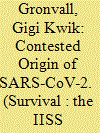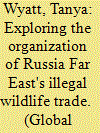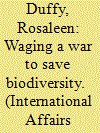| Srl | Item |
| 1 |
ID:
181685


|
|
|
|
|
| Summary/Abstract |
This article describes what is known about the origin of SARS-CoV-2, with implications for policy, biological research and public-health surveillance. Theories about the origin include a natural emergence; a laboratory accident with a naturally harvested strain; an accident with a naturally harvested strain modified in a laboratory; and the deliberate creation of a biological weapon. While available scientific evidence points to a natural zoonotic event as the origin of SARS-CoV-2, this paper recommends specific steps governments and scientific institutions should take to address uncertainties about the origin of the COVID-19 pandemic, as well as to make all potential causes for a pandemic less likely to produce one in the future. Immediate steps include promoting international scientific collaboration, addressing scientific misinformation and disinformation, fully implementing ‘One Health’ and reining in the illegal wildlife trade.
|
|
|
|
|
|
|
|
|
|
|
|
|
|
|
|
| 2 |
ID:
087466


|
|
|
|
|
| Publication |
2009.
|
| Summary/Abstract |
The Russian Federation is a source of wildlife and wildlife products that fuel the vast, and often overlooked, illegal wildlife trade that takes place around the globe. Out of the many illicit animal and plant trades, two of these black markets - the illegal fur trade and the illegal falcon trade - are used in this article to explore the organization of this illicit activity in Russia Far East. Using interviews from Russian and other wildlife trade experts, structural frameworks are established for each of these illegal wildlife markets.
|
|
|
|
|
|
|
|
|
|
|
|
|
|
|
|
| 3 |
ID:
114632


|
|
|
|
|
| Publication |
2012.
|
| Summary/Abstract |
Parrots are amongst the most beautiful and intelligent bird species in the world. They have been coveted as pets for centuries, particularly in the neo-tropics where they are heavily populated. Unfortunately, this has led to dramatic increases in parrot poaching over the last few decades, making parrots the most threatened bird species in the world. Despite laws against parrot poaching throughout the neo-tropics, the illegal trade continues while parrot populations further decline. This article reviews the literature on the players in the illegal parrot trade (i.e. poachers, itinerant fences, and market sellers), how poaching is largely committed, and which species are more at risk of becoming poached.
|
|
|
|
|
|
|
|
|
|
|
|
|
|
|
|
| 4 |
ID:
133284


|
|
|
|
|
| Publication |
2014.
|
| Summary/Abstract |
This article examines the rise in militarized approaches towards conservation, as part of a new 'war for biodiversity'. This is a defining moment in the international politics of conservation and needs further examination. The claims that rhinos and elephants are under threat from highly organized criminal gangs of poachers shapes and determines conservation practice on the ground. Indeed, a central focus of the 2014 London Declaration on the Illegal Wildlife Trade is the strengthening of law enforcement, and recent policy statements by the US government and the Clinton Global Initiative also draw the link between poaching, global security and the need for greater levels of enforcement. Such statements and initiatives contribute substantially to the growing sense of a war for biodiversity. This article offers a critique of that argument, essentially by asking how we define poachers, and if militarized approaches mean conservationists are becoming more willing to engage in coercive, repressive policies that are ultimately counterproductive. Further, this article examines how the new war for biodiversity is justified and promoted by referring to wider debates about intervention in a post-Cold War era; notably that the international community has a responsibility towards wildlife, especially endangered species, and that military forms of intervention may be required to save them.
|
|
|
|
|
|
|
|
|
|
|
|
|
|
|
|